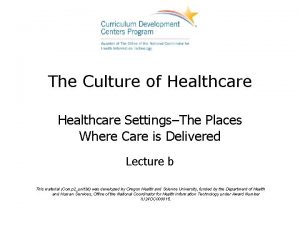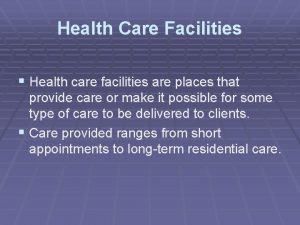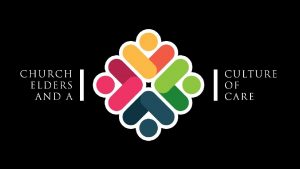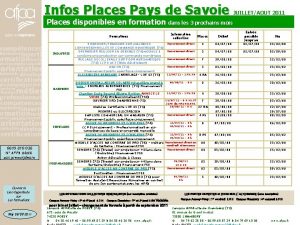The Culture of Health Care SettingsThe Places Where

























- Slides: 25


The Culture of Health Care Settings—The Places Where Care Is Delivered Lecture b This material (Comp 2 Unit 3) was developed by Oregon Health and Science University, funded by the Department of Health and Human Services, Office of the National Coordinator for Health Information Technology under Award Number IU 24 OC 000015. This material was updated in 2016 by Bellevue College under Award Number 90 WT 0002. This work is licensed under the Creative Commons Attribution-Non. Commercial-Share. Alike 4. 0 International License. To view a copy of this license, visit http: //creativecommons. org/licenses/by-nc-sa/4. 0/.

Health Care Settings— The Places Where Care Is Delivered Learning Objectives • Differentiate the range of care delivery organizations, including primary care, specialty care, tertiary care, hospitals, clinics, the medical home, home health, hospice, and long-term care facilities. (Lecture a) • Analyze the organization of health care delivery from the perspective of a continuum of care, including outpatient services, inpatient services, home care services, longterm care, and end-of-life care. (Lecture a) • Evaluate the similarities and differences of community hospitals, teaching hospitals, specialty hospitals, and community health clinics. (Lecture a) 3

Health Care Settings— The Places Where Care Is Delivered Learning Objectives Continued • Describe the various departments and services offered by an outpatient clinic, community hospital, academic medical center, and long-term care facility. (Lecture b) • Explain the ways in which different outpatient and inpatient departments interact and how their services relate. (Lecture b) • Describe ways data and information are created and used by people in different outpatient and inpatient departments. (Lecture b) • Describe ways in which medical and information technology have improved interdepartmental communication and, consequently, the patient experience. (Lecture b) 4

Structure and Function of Health Care Organizations • Departments and functions of health care organizations • How these organizations interact • Types and use of data by the departments • Technology’s impact on interdepartmental communication and patient experiences 5

Health Care Provider Organizational Chart 3. 3 Chart: Example of a health care organizational structure. Hickman, 2012. CC-BY-NC-SA. 6

Roles and Responsibilities 3. 4 Chart: Example of a chief medical information officer reporting structure. CC BY by Jan Kraus Read more: http: //www. businessdictionary. com/definition/human-resourcesmanager. html#ixzz 41 Nif 3 j. NZ 7

Additional Leadership Roles • • Vice president of human resources Chief nursing officer (CNO) Chief nursing information officer (CNIO) Chief analytics and data officer Chief security officer (CSO) Chief compliance officer (CCO) Chief legal officer (CLO) 8

Medical Staff • Typically has an elected chief of staff • Chief of staff and CMO manage – Physician privileges – Medical polices – Governance of medical staff – Continuing medical education – Quality and patient safety initiatives • VP of quality & patient safety 9

Nursing 3. 5 Chart: Example of nursing department organization chart. CC BY by Vivian Todhunter University of Rochester Medical Center, 2011 10

Clinical Support Services 3. 6 Figure: Support services grouping. CC BY by Vivian Todhunter 11

Ancillary Services 3. 7 Figure: Ancillary services grouping. CC BY by Vivian Todhunter 12

Information • Management varies • Examples – Admitting – Medical records – Information technology United Hospital Fund, 2008; Medicare Payment Advisory Committee, 2004 13

Information Technology Department 3. 8 Figure: Example of IT department relationships. CC BY by Vivian Todhunter 14

Facilities Management • Senior manager • Examples – Housekeeping – Maintenance – Security 15

Organizational Structure by Institution • Core functions • Size • Type 16

Patient Clinical Data Types • • • Narrative, textual Numerical measurements Recorded signals Drawings Photographs and images Shortliffe & Barnett, 2006 17

Communication • Verbal • Paper • Film/analog 18

Digital Communication • Digital – Electronic health record – Patient sourced information – Personal health record and portals • Definitions: – https: //www. healthit. gov/providers- professionals/faqs/what-personal-health-record – https: //www. healthit. gov/providersprofessionals/faqs/what-patient-portal 19

Patient Experience • • History Testing Data quality Information access 20

Health Care Settings—The Places Where Care Is Delivered Summary – Lecture b • The following were discussed in this lecture: – Range and continuum of care – Unique types of health care organizations and relationships between organization – Organizational structure and function – Relationships and communication between departments – Effect of technology on the patient experience 21

Health Care Settings—The Places Where Care Is Delivered Summary • This unit – Differentiated range of care delivery organizations – Analyzed the organization of health care delivery from – – – the perspective of a continuum of care Evaluated similarities and differences of community hospitals, teaching hospitals, community health clinics Described departments and the services they offer Explained how departments and services interact Discussed data and information Described the impact of medical and information technology 22

Health Care Settings—The Places Where Health Care Is Delivered References – Lecture b References Health. IT. gov. (2013). What is a personal health record? Retrieved from https: //www. healthit. gov/providers-professionals/faqs/what-personal-health-record Health. IT. gov. (2015). What is a patient portal? Retrieved from https: //www. healthit. gov/providersprofessionals/faqs/what-patient-portal Longnecker, D. E. , Patton, M. , & Dickler, R. M. (2007). Roles and responsibilities of chief medical officers in member organizations of the Association of the American Medical Colleges. Academic Medicine, 82(3), 258– 263. Retrieved from http: //mobile. journals. lww. com/academicmedicine/_layouts/15/oaks. journals. mobile/articleviewer. as px? year=2007&issue=03000&article=00009 Medicare Payment Advisory Committee. (2004). Information technology in health care. In Report to the Congress: New approaches in Medicare, chapter 7. Retrieved from http: //qio. ipro. org/wpcontent/uploads/2012/12/june 04_entire_report. pdf Scribd. (2011). Organizational structure of a hospital. Retrieved from http: //www. scribd. com/doc/20884108/Organizational-Structure-of-a-Hospital. Shortliffe, E. H. , & Barnett, G. O. (2006). Biomedical data: Their acquisition and use. In E. H. Shortliffe & J. J. Cimino (Eds. ), Biomedical computer applications in health care and biomedicine, 3 rd ed. , pp. 403– 443. New York: Springer. United Hospital Fund. (2008). Family care giver guide. Hospital admission: How to plan and what to expect during the stay. Retrieved from http: //www. nextstepincare. org/uploads/File/ Hospital_Admissions. pdf 23

Health Care Settings—The Places Where Health Care Is Delivered References – Lecture b Continued University of Rochester Medical Center. (2007). Strong Memorial Hospital organizational chart. Retrieved from http: //www. urmc. rochester. edu/strongnursing/about/documents/Nursing. Org. Chart. pdf Web. Finance. (2016). Human resources manager. In Business. Dictionary. com. Retrieved from http: //www. businessdictionary. com/definition/human-resources-manager. html#ixzz 41 Nif 3 j. NZ Charts, Tables, Figures 3. 3 Chart: Example of a health care organizational structure (Hickman 2012, CC BY-NC-SA 3. 0). 3. 4 Chart: Example of a chief medical information officer reporting structure. CC-BY by Jan Kraus. 3. 5 Chart: Example of a nursing department organization chart. CC BY by Vivian Todhunter. 3. 6 Figure: Support services grouping. CC BY by Vivian Todhunter. 3. 7 Figure: Ancillary services grouping. CC BY by Vivian Todhunter. 3. 8 Figure: Example of IT department relationships. CC BY by Vivian Todhunter. 24

The Culture of Health Care Settings—The Places Where Care Is Delivered Lecture b This material was developed by Oregon Health & Science University, funded by the Department of Health and Human Services, Office of the National Coordinator for Health Information Technology under Award Number IU 24 OC 000015. This material was updated in 2016 by Bellevue College under Award Number 90 WT 0002. 25
 Primary secondary tertiary care nursing
Primary secondary tertiary care nursing Health and social care unit 2
Health and social care unit 2 Health and social care component 3
Health and social care component 3 Dahlgren and whitehead 1991
Dahlgren and whitehead 1991 Key issue 3 why do some places face health challenges
Key issue 3 why do some places face health challenges Popular culture example
Popular culture example Individual culture traits combine to form culture patterns.
Individual culture traits combine to form culture patterns. Batch culture vs continuous culture
Batch culture vs continuous culture Fed-batch
Fed-batch Collectivistic cultures
Collectivistic cultures Indian vs american culture
Indian vs american culture Uses of selenite f broth
Uses of selenite f broth Folk culture and popular culture venn diagram
Folk culture and popular culture venn diagram Subculture group
Subculture group How does popular culture diffuse
How does popular culture diffuse Anaerobic media
Anaerobic media Folk culture and popular culture venn diagram
Folk culture and popular culture venn diagram Inert organizational culture
Inert organizational culture Lawn culture method
Lawn culture method Robertson cooked meat medium
Robertson cooked meat medium Characteristics of quality culture
Characteristics of quality culture Surface culture deep culture and esol
Surface culture deep culture and esol Madeleine leininger theory
Madeleine leininger theory Teori caring menurut madeleine leininger adalah
Teori caring menurut madeleine leininger adalah Mersey care just culture
Mersey care just culture Hình ảnh bộ gõ cơ thể búng tay
Hình ảnh bộ gõ cơ thể búng tay
















































